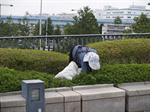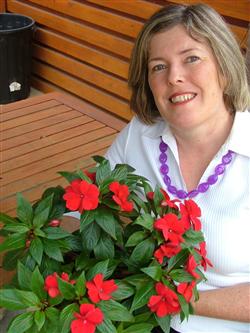A Professional Garden Maintenance Course that Trains you as a Professional too!
Professional gardeners are hard to find: many people
are able to maintain gardens, but not many are able to do it well.
Gardening entails more than just mowing lawns, carting away rubbish or
pulling out a few weeds; you really need to have broad knowledge of all
the aspects of proper garden care to get those plum jobs.
 Learn to Fertilize, Water, Prune, Control weeds, Pests and Disease, and more
Learn to Fertilize, Water, Prune, Control weeds, Pests and Disease, and more- Start a gardening business, or seek work as a gardener
- Learn to better manage your own garden
Lesson Content and Structure
There are 10 lessons in this course:
1. Introduction Planning and Managing a garden.
- Cost of Maintenance
- Expensive and Less Expensive areas of a garden
- Planning
- Garden Checklists
- Analyzing Maintenance of Parks and Gardens
- Organising Garden Maintenance Staff
2. Garden Furnishings and Machinery
- What Tool for What Job
- Overview of Machinery
- Mowers and How to Mow
- Aerators, Chippers, Mechanised Sprayers, Chain Saws, Brush Cutters, etc.
- Tractors
- Tool Maintenance
- Engine Troubleshooting
- Outdoor Furniture -plastic, timber, metal
- Protecting Furnishings -paints, stains, preservatives
3. Feeding Plants
- Symptoms of Nutritional and other Problems
- Conducting an Inspection of Plants
- Soil Characteristics and identification of Soil Issues
- Review of Plant Nutrition
- Choosing the Right Fertiliser
- Diagnosing Nutritional Problems
- Improving soils
4. Weed Control
- Nature and Scope of Weed Problems
- Natural Ways to Control Weeds -suffocation, burning, cultivation, etc
- Common groups of weeds and options for treating and recognising different weed varieties.
5. Weedicides
- How Weeds Spread
- Types of chemicals found in weedicides and suitable weedicide
- Which chemical would control the weed.
- Chemicals and the Law
 6. Natural Pest Control
6. Natural Pest Control
- Scope and Nature of Natural Controls
- Cultural Controls
- Mechanical Control Methods
- Physical Control Methods
- Methods for controlling selected insects
- Companion Planting
- Common Environmental Problems
- Tolerance Levels in different plants
- Biological Controls
- Natural Sprays
- Buffer Zones
- Mulching
7. Chemical Pest Control
- Integrated Pest Management (IPM)
- Ways of Applying Chemicals
- Safety with Chemicals
- Understanding Pesticides -toxicity, LD50, Persistence, etc.
- Specific chemical treatments and a summary of pesticides.
8. Turf Management
- Common Turf Problems
- Turf Pests
- Chemical Damage
- Establishment and Maintenance of Lawns
- Mowing, Fertilizing, Aeration, etc
Turf varieties, appropriate turf for specific areas, low and high maintenance turf.
9. Irrigation
- Importance of Water
- Water Loss from different soils & Improving Water retention
- Understanding Water Dynamics in soil
- Irrigation -types of systems
- Planning an irrigation system
- Using an irrigation system
- Controlling slippery surfaces
10. Maintenance of Plants
- Why Prune
- Before Pruning
- Time of Pruning -does it matter?
- What to consider when pruning
- Removing Dead Wood
- Controlling shape and size
- How to prune different types of plants
Each lesson culminates in an assignment which is submitted to the school, marked by the school's tutors and returned to you with any relevant suggestions, comments, and if necessary, extra reading.
Aims
- Select and maintain tools and equipment appropriately for use in garden maintenance.
- Describe maintenance requirements for garden structures such as furniture, gates and fencing.
- Maintain appropriate nutrition requirements for healthy plant growth.
- Control weeds in a garden.
- Use weedicides in a safe and effective way.
- Control pests using non chemical methods.
- Use chemical pesticides safely and efficiently.
- Maintain lawns in a healthy and well maintained condition.
- Describe options for managing water in a garden.
- Determine actions that should be taken to maintain a variety of different plants.
Course Duration: Self paced, 100 hrs
Suggested Book - Starting a Garden or Landscape Business by John Mason (click for details) is a good place to start if you want to get a better understanding of this industry and what is involved going into business for yourself. John Mason has over 40 years experience working in this industry across both Australia and the UK, and this book is an invaluable reflection of what he has observed and learnt. Don't make the same mistakes that have brought down so many other businesses. Follow the suggestions that have led so many others to success. http://www.acsbookshop.com/product-starting-a-garden-or-landscape-business-pdf-ebook-5824.aspx

Tips for Renovating a Garden
If your garden is tired and run down, don’t worry. Most old gardens can be brought back to life relatively easily, if you are prepared to put in a little money and effort.
The hardest thing about establishing any garden from the beginning is to design and establish the broad structure. This includes the shape and location of paths, lawns, garden beds and paved areas. Buildings and other structures such as fences and walls have to be constructed, while water features, drainage and soil shaping all need to be considered.
When you renovate an old garden you have the advantage that most of the broad structure is in place. Renovation is easier and cheaper than starting from scratch. Some components may need cleaning, repairing, replacing or maybe even altering, but there is usually a lot that can be used. That means a garden renovation can provide quicker results than a totally new garden construction on a bare area of land.
WHERE TO START
This is the biggest problem for everyone faced with “fixing up” an established garden.
Before you begin, the task can seem daunting. But it can be done, particularly if you break the work down into bite-sized chunks that can be considered and acted upon one by one.
If the job seems impossible you should tackle the easiest task in the easiest part of the garden first. After this, just take it step by step.
As with anything in life, you need to be motivated, and the best way to develop and maintain motivation is to tackle something that is achievable; and with each success you have, your confidence to tackle the next job will increase.
BE PREPARED
Many weeds and plants can scratch or cause allergic reactions. You will also be more likely to find spiders, snakes, ants, mosquitoes, etc. in areas that have been relatively undisturbed for long periods. So:
- Wear protective gear: a hat, gloves, long pants and long sleeves, solid footwear and possibly a mask.
- Choose appropriate weather conditions (too hot or too wet can be dangerous and non-productive).
- If you are subject to allergies or sensitivities, take an antihistamine tablet before starting work.
- Have a first aid kit on hand.
- Work out where you are going to put rubbish before you start gathering it up.
THE PROCEDURE
1st Assess the components
- List the broad components of the garden and note their condition.
2nd Evaluate the overall structure
- Consider how all of the components fit together.
- Consider if any need to be removed, replaced or altered.
- Decide if there are any new elements you would like to add.
3rd Make a list of the tasks that need to be done.
4th Prioritise the tasks.
WHAT ORDER TO WORK IN
- Give the garden a clean up first so that you can see what you are doing. This involves cutting back, weeding and removing rubbish. Hiring a rubbish skip can make this easier.
- Some people like to work systematically through the garden; finishing off one area before moving to the next (eg. front garden first, then the outdoor living area, and then back garden.)
- Make sure you attempt the tasks in a logical order. For example, don’t start adding plants before you have finished constructing the garden bed.
- If you have a particular skill that you are most comfortable with (eg. working with timber, paving, pruning plants or concreting), it may be wise to do the tasks involving that skill first. The tasks you are more comfortable with will get achieved more easily, and that should give you the confidence to move on to other tasks.
- It is often wise to concentrate on the broad structure first. Many professional gardeners will tell you: get the structural elements like paving, walls and buildings right; and the detail (eg. planting, statuary, etc), will be much easier to add later.
KNOW YOUR LIMITATIONS
Some aspects of the project may require you to get in an expert. For example: tree removal should be undertaken by a fully insured tree surgeon, rock work might require mechanical lifting equipment, and laying concrete requires specialist skills.
RENOVATING AREAS IN YOUR GARDEN
DEALING WITH THE WEEDS
-Cut back then spray regrowth.
-Make sure you don’t spread weed seeds.
-Suffocate weeds with weed mat or mulch.
-Know your weeds and if they are persistant perennials; try to get the roots out.
PAVING
-Remove any weeds that have come up between the paving.
-Remove and replace any broken pavers.
-If the surface has become uneven, consider lifting the uneven sections and relaying the pavement at the correct levels.
-In flexible paving fill any gaps between the pavers with jointing sand.
-In fixed paving fill any gaps between the paving with fresh mortar or concrete.
TREES AND SHRUBS
-Remove trees and shrubs that have become too big or have rotted and become dangerous.
-Remove trees and shrubs that have grown too close to fences, buildings and ponds.
-Prune back overhanging branches.
-Remove suckers from around trees.
-Prune plants to the desired shape.
GARDEN BEDS
-Remove weeds.
-If necessary, add soil, fertiliser or both.
-Mulch exposed areas of soil.
-Add new plants
LAWNS
Once you have cut back your jungle, you might find a spot where there once was lawn. Depending on the site, there are a number of things you might need to do to restore the lawn:
-Install drainage in waterlogged sites.
-Rotary hoe the soil.
-Cut the grass very low to remove layers of thatch.
-Sow grass seed on bare patches.
-Topdress the soil with a sandy loam soil.
-Apply fertiliser.
PONDS
Ponds require constant maintenance. If a pond has been allowed to stagnate or become polluted, it will be necessary to empty the pond and start again.
-Remove any fish and any desirable plants, and house them safely.
-Remove the water along with any undesirable plants.
-Clean the sides of the pond.
-Refill with clean water.
-Once the water has stablised, return aquatic life to the pond.
FURNITURE AND STATUARY
Furniture and statuary can be given a new lease of life by cleaning, repairing, removing old paint with a wire brush or sandpaper, and then applying a new coat of paint.
Who Should Study This Course?
It is suitable training for:
- The gardening professional.
- Thoe starting a garden maintenance business of your own
- The beginner gardener - working for a head gardener or as an employee in garden maintenance
- Garden enthusiasts or those wanting to learn how to maintain their own garden effectively
MEET OUR EXPERTS
Tutors and course writers from ACS include a team of leading horticulture professionals with a combined experience of many years working across the world.
|
|
|
|
John L. Mason Dip.Hort.Sc., Sup'n Cert., FIOH, FPLA, MAIH, MACHPER, MASA
Mr Mason has worked in horticulture since 1971 when he graduated from Australia's leading Horticultural College -Burnley. He has worked extensively around the world, in both Victoria and Queensland (Australia) and the UK. Former nurseryman, landscaper, parks director and horticultural consultant. Editor of 5 gardening magazines, author of more than 70 books, including 'Trees and Shrubs for Small Gardens' and 'Orchids: A beginners Guide'. John
started teaching in the early 1970's.
|
Dr Lynette Morgan B.Hort.Tech(Hons), PhD in hydroponic greenhouse production
Partner in SUNTEC International Hydroponic Consultants, Lynette is involved in many aspects of production horticulture production, including remote and on site consultancy services for new and existing commercial greenhouse growers worldwide as well as research trials and product development for manufacturers of hydroponic products. Lynette is also the author of 6 hydroponic technical books
|
Bob James QDAH. B. Applied Sc(Hort Tech),Grad Dip. Mgt, M;Sc (Enviro Sc.), PDC.
Bob has over 50 years experience in Government and Private Horticulture and Environmental Management Consulting.
His work is diverse across most branches of horticulture including nurseries, landscaping, horticultural education, environmental assessment, land rehabilitation; and more.
|
 |
 |
 |
|
Adriana Fraser Cert.Hort., Cert.Child Care, Adv.Cert.App.Mgt., Cert 1V W'place Assess & Training, Adv.Dip.Hort.
Over 25 years of experience in horticulture, business and writing.
Adriana has written regularly for a range of publications (including Australia's national Grass Roots Magazine) since the early 1980's. She operated a herb garden in her previous home, hosting visits regularly from groups of students for plant identification and propagation lessons. She has worked in TAFE as a teacher and in community education as well as project management for the establishment of public parks and gardens. She continues to be actively involved in writing, horticultural consultancy and organic and practical gardening; in addition to her work for ACS.
|
Maggi Brown
Maggi is regarded as an expert in Organic Growing throughout the UK, having worked for two decades as Education Officer at the world renowned Henry Doubleday Research Association. She has been active in education, environmental management and horticulture across the UK for more them three decades. She has exhibited at Chelsea Flower show and worked widely as a consultant for decades. |
Gavin Cole B.Sc., Cert.Garden Design, MACA
Gavin has three decades of industry experience in Landscaping, Publishing and both the UK and Australia, across landscaping and the amenity plant sector. He was operations manager for a highly reputable British Landscape firm (The Chelsea Gardener) before starting up his own firm. He spent the best part of three years working in our Gold Coast office
|
 |
 |
|
Diana Cole B.A. (Hons), Higher Dip. (Garden Design), RHS Advanced Cert. Horticulture, Cert Admin.Mgt., Dip. Inst. Personnel Management
In addition to her RHS horticulture, garden design, City & Guild construction, NPTC pesticide/legislation and business/management qualifications, Diana has a variety of skills drawn from setting up Arbella Gardens, a landscape gardening business. She also has administrative, management and training delivery experience drawn from her employment in other organisations such as the NHS and other educational institutions such as schools & universities. She has augmented her training expertise having gained the Preparing to Teach in the Life Long Learning Sector qualification. She also has experience gained through working as a volunteer in a number of different roles including amenity style gardening in parks and practical conservation work.
|
Rosemary Davies Dip Hort Sc. Originally from Melbourne, Rosemary trained in Horticultural Applied Science at Burnley, a campus of Melbourne University. Initially she worked with Agriculture Victoria as an extension officer, taught horticulture students, worked on radio with ABC radio (clocking up over 24 years as a presenter of garden talkback programs, initially the only woman presenter on gardening inVictoria) and she simultaneously developed a career as a writer. She then studied Education and Training, teaching TAFE apprentices and developing curriculum for TAFE, before taking up an offer as a full time columnist with the Herald and Weekly Times and its magazine department after a number of years as columnist with the Age. She has worked for a number of companies in writing and publications, PR community education and management and has led several tours to Europe. In 1999 Rosemary was BPW Bendigo Business Woman of the Year and is one of the founders and the Patron, of the Friends of the Bendigo Botanic gardens. She has completed her 6th book this year and is working on concepts for several others.
|